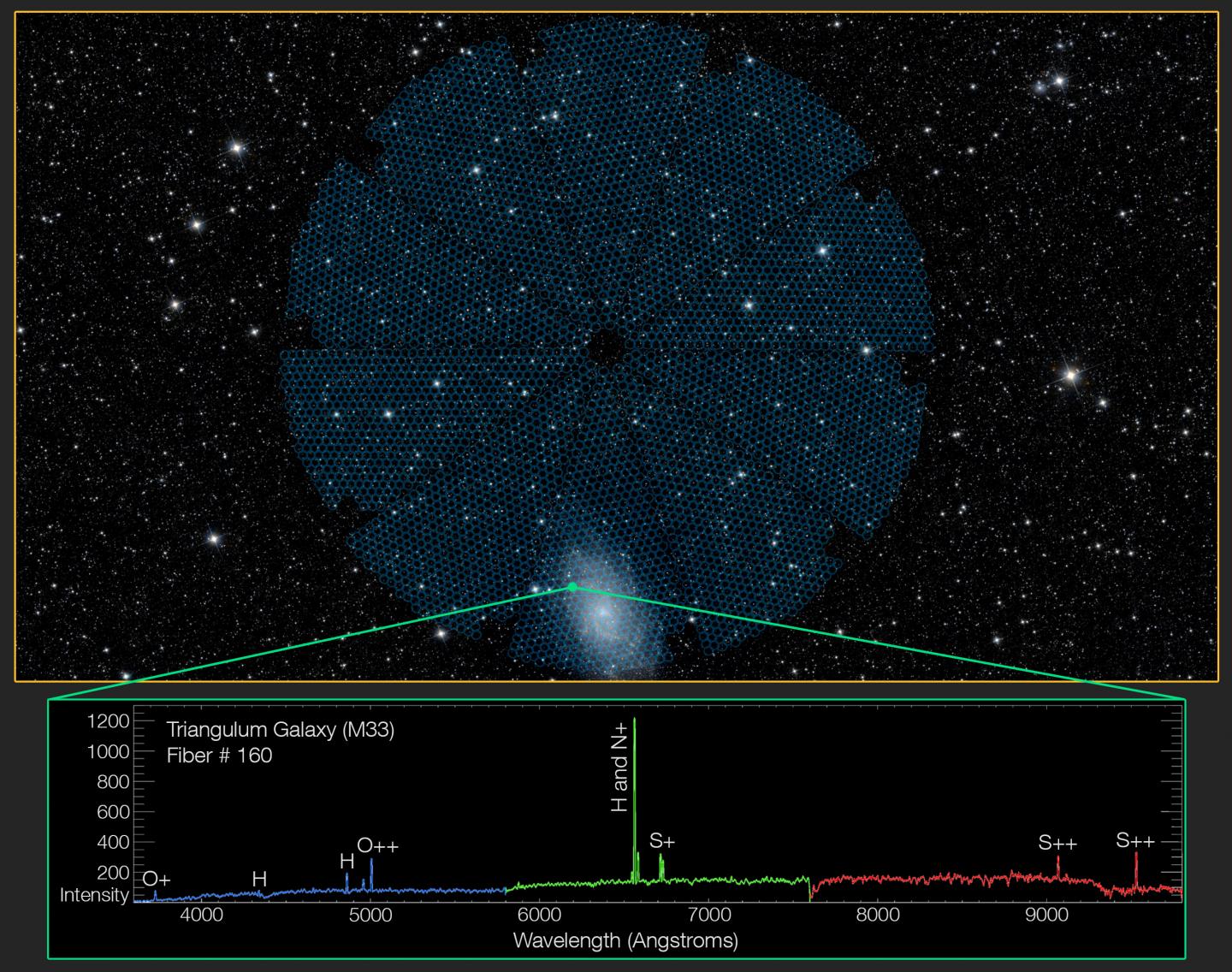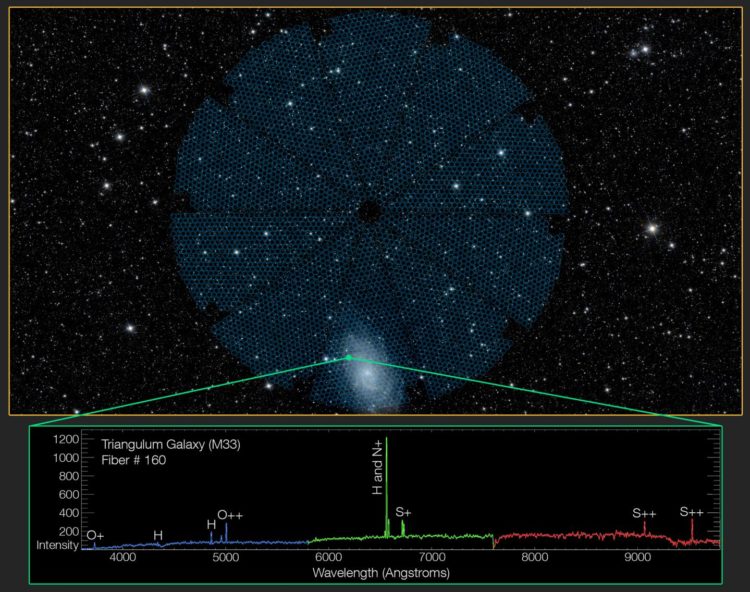Installation of the Dark Energy Spectroscopic Instrument nears completion

Credit: DESI Collaboration; Legacy Surveys; NASA/JPL-Caltech/UCLA; NSF’s National Optical-Infrared Astronomy Research Laboratory
A 3D map of the Universe that will probe the nature of dark energy draws one step closer
A new instrument on the 4-m Mayall telescope has opened its array of thousands of fiber-optic “eyes” to the cosmos and successfully captured the light from distant galaxies. The milestone marks the beginning of final testing for the Dark Energy Spectroscopic Instrument (DESI), which is poised to begin creating the most detailed map of the Universe ever undertaken. The Mayall telescope is located at Kitt Peak National Observatory(KPNO), which is operated by the National Science Foundation’s National Optical-Infrared Astronomy Research Laboratory (NSF’s OIR Lab).
Mapping to Understand Dark Energy
Beginning early next year, DESI will embark on a five-year mission to map the cosmos. Its goal: to chart the positions and distances of 35 million galaxies spread across 1/3 of the sky and over cosmic time, as far back as 11 billion years ago. DESI will also study 10 million stars in our galaxy, the Milky Way. The undertaking will tackle one of the most puzzling and profound problems in physics: the nature and physics of dark energy, an unknown form of energy that is currently understood to permeate the Universe and accelerate its expansion.
To measure the distances to galaxies, DESI takes the fingerprint of a galaxy by measuring its spectrum: the light from individual galaxies is dispersed into fine bands of color to measure a galaxy’s redshift and its distance from Earth. To measure the distances to millions of galaxies, DESI is highly multiplexed and employs state-of-the-art technology. Robotic positioners automatically point DESI’s fiber-optic eyes at preselected sets of galaxies, 5000 at a time, and by measuring their spectra, gauge how much the Universe expanded as their light traveled to Earth. In ideal conditions, DESI can study more than 100,000 galaxies a night.
“After a decade in planning and R&D, installation and assembly, we are delighted that DESI can soon begin its quest to unravel the mystery of dark energy,” said DESI Director Michael Levi of the Department of Energy’s Lawrence Berkeley National Laboratory (Berkeley Lab), the lead institution for DESI’s construction and operations.”Most of the Universe’s matter and energy are dark and unknown, and next-generation experiments like DESI are our best bet for unraveling these mysteries,” Levi added. “I am thrilled to see this new experiment come to life.”
A Venerable Telescope at the Forefront of Discovery
The installation of DESI at the 46-year-old Mayall telescope, begun in February 2018, marks the Mayall’s successful transformation from an “all-purpose research tool” to more a specialized facility at the forefront of technology and discovery.
“With DESI we are combining a modern instrument with a venerable old telescope to make a state-of-the-art survey machine,” said Lori Allen, Director of KPNO at NSF’s OIR Lab. The Lab, created recently from the unification of National Optical Astronomy Observatory (NOAO), Gemini Observatory, and LSST operations, is the preeminent US center for ground-based optical-infrared astronomy.
Today’s surveys of many millions of objects require large fields of view — the ability to study large areas of sky in a single pointing — and large, heavy equipment.
“Despite its age, the well-maintained Mayall telescope is the perfect platform for DESI,” said David Sprayberry, KPNO Site Director for DESI. “Because it was originally designed for a wide field, the Mayall’s optical design was easily adapted to the very wide field-of-view needed for DESI. The telescope is also sturdy enough to carry DESI’s massive weight.”
The DESI instrument weighs about 11 tons. It also has a field-of-view of 8 square degrees, or approximately 40 times the area of the full moon.
Teamwork and Technology
The DESI project and the installation of the DESI instrument is as much about teamwork as it is about technology. The DESI collaboration includes nearly 500 researchers at 75 institutions in 13 countries.
“The DESI instrument is complex and one-of-a-kind. It would never have been possible without a large and capable collaboration, with components coming from throughout the US and Europe. It is very exciting to see this instrument come together almost flawlessly, thanks to the close cooperation of the many remote teams involved,” said Parker Fagrelius, KPNO’s Observing Operations Supervisor for DESI.
Over the past 18 months, a multitude of DESI components were shipped to Kitt Peak from institutions around the globe and installed on the telescope.
These components include a set of six large lenses packaged in a steel barrel, which has been installed above the telescope’s primary mirror, giving the instrument its expansive field of view. The lenses, each about a meter across, were successfully tested in April.
Another major component is DESI’s focal plane, which sits at the top of the telescope and carries the 5000 robotic positioners that swivel in a choreographed “dance” to select individual galaxies and stars for study.
Most recently arrived are DESI’s spectrographs, eight of which have been installed, with the final two arriving before year’s end. Approximately 240 km (150 miles) of fiber-optic cabling connects the focal plane at the top of the telescope with DESI’s spectrographs located beneath the telescope.
A Powerhouse Engine of Discovery
Although it was designed to study dark energy, DESI will also make unexpected discoveries, because the spectral “fingerprints” of stars and galaxies that DESI will collect encode much more information than is needed to carry out the DESI project.
“DESI is perfectly designed for the exploration of the unknown. Among the millions of galaxies and stars DESI will study, there are rare, perhaps one-of-a-kind, astronomical sources, some completely unanticipated, that await discovery,” said Arjun Dey (KPNO), Head of Observing Operations for DESI. By exploring the cosmos on this scale, DESI may also uncover new phenomena and perhaps even new physics, similar to how dark energy itself was discovered.
“Discovering the unexpected — that’s the most exciting part of the whole thing for me,” Dey said.
###
More Information
NSF’s National Optical-Infrared Astronomy Research Laboratory, the US center for ground-based optical-infrared astronomy, operates the Gemini Observatory, Kitt Peak National Observatory (KPNO), Cerro Tololo Inter-American Observatory (CTIO), the Community Science and Data Center (CSDC), and the Large Synoptic Survey Telescope (LSST). It is managed by the Association of Universities for Research in Astronomy (AURA) under a cooperative agreement with NSF and is headquartered in Tucson, Arizona. The astronomical community is honored to have the opportunity to conduct astronomical research on Iolkam Du’ag (Kitt Peak) in Arizona, on Maunakea in Hawai’i, and on Cerro Tololo and Cerro Pachón in Chile. We recognize and acknowledge the very significant cultural role and reverence that these sites have to the Tohono O’odham Nation, to the Native Hawaiian community, and to the local Communities in Chile, respectively.
The National Science Foundation (NSF) is an independent federal agency created by Congress in 1950 to promote the progress of science. NSF supports basic research and people to create knowledge that transforms the future.
DESI is supported by the US Department of Energy’s Office of Science; the US National Science Foundation, Division of Astronomical Sciences under contract to the NSF’s National Optical-Infrared Astronomy Research Laboratory; the Science and Technologies Facilities Council of the United Kingdom; the Gordon and Betty Moore Foundation; the Heising-Simons Foundation; the French Alternative Energies and Atomic Energy Commission (CEA); the National Council of Science and Technology of Mexico; the Ministry of Economy of Spain; and DESI member institutions. The DESI scientists are honored to be permitted to conduct astronomical research on Iolkam Du’ag (Kitt Peak), a mountain with particular significance to the Tohono O’odham Nation. View the full list of DESI collaborating institutions, and learn more about DESI here: desi.lbl.gov.
Contacts
Lori Allen
Director, Kitt Peak National Observatory
National Optical-Infrared Astronomy Research Laboratory
Tel: +1 520-318-8281
Email: [email protected]
Arjun Dey
National Optical-Infrared Astronomy Research Laboratory
Tel: +1 520-318-8429
Email: [email protected]
David Sprayberry
National Optical-Infrared Astronomy Research Laboratory
Tel: +1 520-318-8372
Email: [email protected]
Joan Najita
National Optical-Infrared Astronomy Research Laboratory
950 N Cherry Ave, Tucson AZ 85719 USA
Tel: +1 520-318-8416
Email: [email protected]
Media Contact
Joan Najita
[email protected]
520-318-8416
Original Source
https:/





